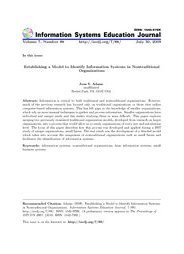Volume 7
Volume 7, Number 88 |
July 30, 2009 |

|
Jean S. Adams
|
Abstract: Information is critical to both traditional and nontraditional organizations. However, much of the previous research has focused only on traditional organizations or those that utilize computer-based information systems. This has left gaps in the knowledge of smaller organizations, which rely on more manual techniques to gather and process information. Smaller organizations have individual and unique needs and this makes studying them in mass difficult. This paper explores merging two previously examined traditional organization models, developed from research on larger organizations, into a process that would allow us to study organizations of every size and automation level. The focus of this paper describes how this process was developed and applied during a 2007 study of unique organizations, small farms. The end result was the development of a blended model which takes into account the uniqueness of nontraditional organizations such as small farms and facilitates the identification of information systems.
Keywords: information systems, nontraditional organizations, farm information systems, small business systems
Download this issue: ISEDJ.7(88).Adams.pdf (Adobe PDF, 9 pages, 493 K bytes)
Preview the contents: Adams.j.txt (ASCII txt, 26 K bytes)
Recommended Citation: Adams (2009). Establishing a Model to Identify Information Systems in Nontraditional Organizations. Information Systems Education Journal, 7 (88). http://isedj.org/7/88/. ISSN: 1545-679X. (A preliminary version appears in The Proceedings of ISECON 2007: §3155. ISSN: 1542-7382.)